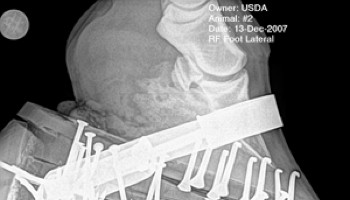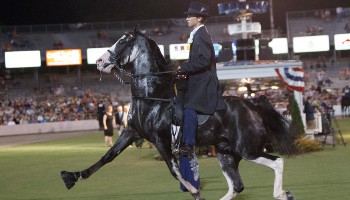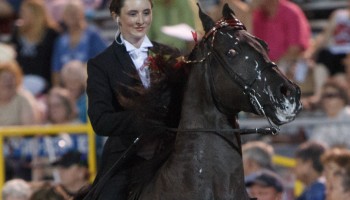The curtains need to close on intentional horse abuse

Reprinted with permission from https://www.rspca.org.uk/-/blog-curtain-close-on-horse-abuse
A guest blog by Dr Mark Kennedy, our senior scientific manager for equines.
Looking at the horse in the above image, with bandaged legs and strange ‘platform shoe’ contraptions applied to his hooves, you’d be forgiven for thinking that he’s in a veterinary hospital receiving treatment for some dreadful accident.
The tightness in his cheek muscles, the tension so clearly visible above his eyes – all indicators that the animal is in considerable pain according to the Horse Grimace Scale. The tragedy is, this is no accident. It’s absolutely deliberate.
DELIBERATE PAIN CONTINUES IN SOME ABUSIVE US HORSE SHOWS
These images show only too clearly the practices some in the Tennessee Walking Horse showing community in the United States are prepared to employ to win competitions where horses are judged on the performance of a hugely exaggerated walk called ‘The Big Lick’.
In addition to the clear ‘pain faces’ (tension above the eyes, white of the eyes showing and tension in the jaw muscles), notice the large weighted platform shoes and chains around the horses’ fore pasterns (ankles) too. The evidence of abuse is undeniable and inexcusable.

The X-Ray image shows the platform shoe (euphemistically known in ‘Big Lick’ circles as a ‘performance package’) with multiple pads (stacks) and lots of nails to hold it all together.
These unsurprisingly add weight and pressure on the sole which most likely increases the discomfort the horse feels. And of all this in a shameful effort to make the horse lift their hooves ever-higher off the ground to achieve the prized Big Lick walk.
HORSES ARE HURTING IN THE MEANINGLESS NAME OF TRIUMPHS AND TROPHIES
If you look, you can also see the large metal band used to hold the contraption to the hoof. Any reasonable person knows that these platform shoes will throw the horses’ feet, legs and entire body out of balance as they move, exposing them to risk of injury and pain through the impact of imbalance on tendons, muscles and joints.
When ridden they’re carrying the weight of the rider as well as their own weight, which increases the pressure on the soles of the feet from the nails in the stacked pads adding further pain.
The chains banging against the horses’ pasterns (also aimed at making them pick their feet up high) are also likely to be very uncomfortable as they move. All of this pain for a chance at winning a trophy.
This isn’t the end of it though. Almost unbelievably, some in the Tennessee Walking Horse community inflict even more abuse on their horses – through a practice known as ‘soring’.
‘SORING’ PRACTICE SEES CHEMICALS “COOKED” INTO HORSES’ FLESH
Soring is the application of an irritant to the forelimbs of horses with the sole intent of inflicting pain and inducing an altered walk (you guessed it – all to win ‘The Big Lick’).
In chemical soring, caustic substances are applied to the horse’s front legs, which are covered tightly with plastic wrap to “cook” the chemicals into the horse’s flesh. Chemicals used include diesel, kerosene, and mustard oil.

Chains are fixed to the horse’s pasterns whenever they’re ridden, causing the horse to snatch them in pain off the ground and throw their weight onto their rear legs. One can only too easily imagine the pain the horse feels when these chains repeatedly bang against the sore sensitised skin of the legs.
Knowing all this, it’s easy to understand why the poor horses perform the unnatural walk seen in these shows. It also too clearly explains their clear pain faces.
Mechanical soring involves cutting the horse’s hoof almost down to the sensitive tissue and nailing on a shoe or standing a horse for hours with the sensitive part of their sole on a block or other raised object. This causes excruciating pressure and pain whenever the horse puts weight on their hoof.
Other cruel techniques involve the use of tight metal bands applied to the hoof to create pressure and pain, as well as the insertion or injection of foreign objects between the sole and the stacked shoe upon which the horse stands.
LAWLESS ABUSE IN THE NAME OF PERSONAL GAIN NEEDS TO END
All of these practices involve nothing less than the absolutely overt, intentional infliction of intense pain on sentient animals for personal gain – the winning of competitions and the money and status this brings. It can only be described as brutal abuse of the horse.
In England and Wales, such practices would be clear breaches of the Animal Welfare Act 2006. The act of inflicting such unnecessary suffering would be immediately open to prosecution.
However, in the United States, these practices happen and they happen regularly – but that is not to say that they are legal there. The United States Congress passed the Horse Protection Act as far back as 1970 with the desire and expectation that doing so would end these cruel practices.
However, due to multiple factors – such as limited jurisdiction granted to the enforcing body (the United States Department of Agriculture), the lengths the abusers are willing to go to avoid complying with the law, and the limited resources available for enforcement – horses are still being abused by soring over half a century later.
HOPE FOR HORSES ON THE HORIZON
There’s hope on the horizon though. In 2010, the Office of the Inspector General of the United States Department of Agriculture reviewed the operation of the 1970 Horse Protection Act and concluded that the enforcing authority program for inspecting horses for soring was inadequate to ensure that this abuse did not occur. It has since made several recommendations for change.
In 2017, the US Secretary of Agriculture finalised a rule amending the Horse Protection Act regulations which would have ended a clearly failed system of industry self-policing and banned the use of platform shoe ‘stacks’ and other ‘action devices’.

This rule change was frozen during the Trump administration, but there are now moves by the Department under the Biden administration to develop and implement an even stronger rule.
In 2021, the groundbreaking Prevent All Soring Tactics (PAST) Act was introduced by US Senators Crapo and Warner with 46 other original bipartisan cosponsors, and by Representatives Cohen, Fitzpatrick, Schakowsky and Buchanan in the US House with 209 other original bipartisan cosponsors.
Our colleague animal welfare organisation, the Humane Society of the United States, have amassed a list of hundreds of endorsements for this act from horse industry groups and professionals to law enforcers, vets (notably the American Veterinary Medical Association and the American Association of Equine Practitioners) and animal protection groups (including the RSPCA).
There’s a powerful movement for change that the RSPCA is delighted to support. As the world’s oldest and largest animal welfare charity, we respectfully ask our transatlantic friends to finally make horse soring a thing of the PAST.
FIND OUT MORE ABOUT THE ISSUE OF SORING
Find out more about soring and the work of the Humane Society of the United States on the issue.
X-ray image credited to United States Department of Agriculture, Public domain, via Wikimedia Commons.
All other images are credited to the Humane Society of the United States.
